Analys
The EUA price could drop to EUR 40/ton and then be picked up by Airliners, Shipping and Utilities

The EUA price is dropping hard along with a sharp decline in the front-year TTF nat gas contract. The typical last-round sell-off in EUA prices have typically been a final sell-off of 10-20-30%. From EUR 60/ton level it implies a price decline down to EUR 54; 48; 42/ton. The front-year nat gas price and the front-year Coal-to-Gas (C-t-G) differential is what has held the EUA price above EUR 60/ton. But if the TTF 2025 price falls down to EUR 27/ton the front-year C-t-G differential will fall all the way towards EUR 40/ton. That TTF 2025 falls to EUR 27/ton or lower seems likely to happen and the risk is high that the EUA price will be sucked down along with it. But nat gas demand is starting to come back with a lag in nat gas price declines in the EU but probably also in Asia. Thus first an over-sell in nat gas prices, then demand revival and then a rebound in both nat gas prices and EUA prices. Airliners, shipping companies and Utilities will probably buy as much EUAs they can get if the EUA price fall down towards EUR 40/ton.

Front-year 2025 TTF nat gas price falls hard and so does the EUA price. The front-month EUA price dropped 2.7% yesterday to EUR 58.97/ton and thus broke out of the sideways trend around EUR 61/ton since 18 January. Today it has sold off another 3.2% to EUR 57.1/ton.
Again it is the nat gas price which is leading the way and more specifically it is about the front-year nat gas which lost 1.9% on Wednesday and another 2.5% again ydy to a close of EUR 30.65/MWh and today it has solf off 2.8% to EUR 29.8/ton.
The EUA price has very clearly been balancing on the front-year Coal-to-Gas (C-t-G) differentials. The C-t-G differentials have been significantly lower than EUR 60/ton both at the front-end of the curve (1-2-3 month) and for calendars 2026 and 2027. But the front-year nat gas price has held up at around EUR 31/MWh quite well since around mid January.
How far down will the EUA price go? The final sell-off could be down towards EUR 40/ton. With these dynamics the big question then becomes: How far down will the front-year nat gas contract sell? It will of course sell off too far as commodities always do. The reason commodities do this is the natural reactive chain of events which normally comes with a lag: First the price goes down before dropping hard in the final round of the sell-off. Then demand comes back with a lag to the price action. This again drives the price back up and off from the lows to a level consistent with the revival in demand. If demand instead had reacted immediately to lower prices then the hard drop at the end of the sell-off might not have happened.
Looking at previous hard, final sell-off-drops in the EUA price we can see that final drops typically have been 10-20-30% as the last final drop. If we take the EUR 60/ton as the starting point of this final drop, then we are talking an EUA price bottom of somewhere in the range of EUR 54; 48; 42/ton.
Global nat gas demand destruction in the face of very high nat gas prices solved the energy crisis. Let’s link this back to price action in nat gas. The reason why Europe has managed the recent energy crisis (Russia/Ukraine, nat gas,…) so surprisingly well is 1) Large reduction in nat gas demand in EU due to exceptionally high prices and 2) Significant demand destruction in Asia freeing up nat gas to flow to the EU. I.e. it was global demand destruction of nat gas in response to extremely high prices globally which solved the energy crisis. It was solved by the global market.
Demand for nat gas is starting to come back as the price falls. The nominal historical average nat gas TTF price was EUR 20/MWh from 2010 to 2019. But the real average was EUR 26/MWh. So seen from the eyes of consumers in both Europe and Asia, a price of EUR 26/MWh is an historically absolutely normal price. Demand for nat gas should thus naturally accelerate back towards normal levels at current nat gas prices. Not just in Europe, but also globally in all regions exposed to nat gas prices set by global LNG prices. This is already happening in the EU. Temp. adj. demand destruction vs. normal has typically been running at around 16% from mid-2022 to December 2023. Average ytd is 14% while the last 15 days is 9%. Demand destruction is fading as the price of nat gas is falling. But do remember that this is also happening in Asia but it is harder to track.
Normal nat gas demand AND normal gas prices is not consistent as Russian nat gas exports still down 1100 TWh/yr. There is however an inconsistency here in expecting normal prices and normal demand for natural gas now onward. The inconsistency is that the EU and thus the world is still robbed of the normal flow of nat gas on pipelines to Europe. This amounts to a loss of 3 TWh/day and thus close to 1100 TWh/year. When this gas is no longer flowing to the EU it isn’t flowing anywhere. It is lost to both the EU and the world. Until that is, Russia has built loads of new pipes to Asia and new LNG terminals. And that takes years.
A return to normal prices and normal demand while the world still is missing 1100 TWh/year of Russian nat gas isn’t really a consistent outcome in our view.
Demand for nat gas will continue to revive as the price of nat gas keeps falling. But both the EU and the world still need of a nat gas price at above normal levels to induce a certain amount of demand destruction until the point in time when new LNG export facilities globally has managed to replace the 1100 TWh/year we have lost from Russia.
Front-end TTF nat gas down to EUR 27/MWh could drive the EUA price to EUR 40/ton. The dynamic sell-off nat gas, prices will likely move lower than to the level which over time is consistent with continued need for some demand destruction globally. This because demand revival will come with a lag to the decline in prices. It is thus fully plausible that the TTF 2025 contract moves all the way down to EUR 27/MWh (or maybe even lower). If so it would imply a 2025 C-t-G differential of only EUR 40/ton for the EUA price to balance on and reference to. That could be the final hard drop in the EUA price. That’s a 30% drop from EUR 60/ton. But it won’t last because that nat gas price is likely too low vs. what is needed globally to maintain some level of demand destruction for a while longer.
An EUA price of EUR 40/ton would also be too cheap to resist for a range of market participants and they’d likely jump in and purchase with both hands. Airliners and shipping companies which will have difficulties of shifting away from fossil fuels and will need EUAs for years to come. Also utilities could step in and purchase large amounts of EUAs even if forward margins are negative. Some EU based utilities with large fossil-based assets bought truckloads of EUAs from 2011 to 2017 when the EUA price ranged from EUR 3/ton to EUR 9/ton. For them the EUA certificate is not only a marginal cost. It is also a licence to operate. The EUA price will of course not return to that level again. But if we move to EUR 40-50/ton, then it will probably trigger strategic buying by shipping companies, airliners as well as utilities.
Front-year TTF nat gas TTF price is dropping and leading the EUA price lower after a period of sideways action since mid-Jan
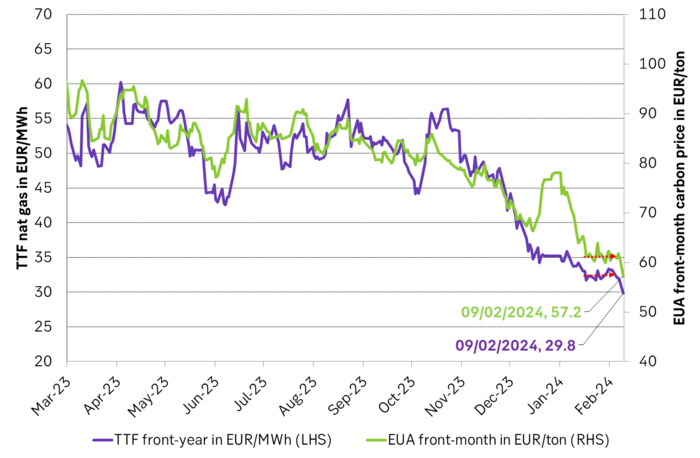
But the EU and the world is still missing some 3 TWh/d or 1100 TWh/yr of piped nat gas from Russia. When Russian nat gas is no longer flowing on pipes to Europe, it is flowing nowhere.
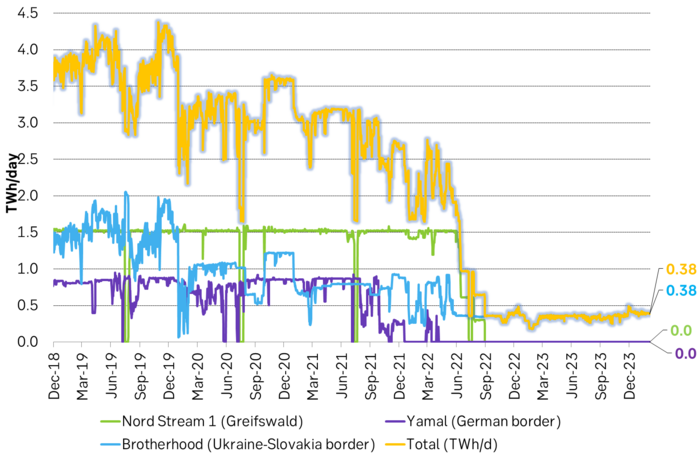
Nat gas demand destruction in the EU has been running at 15% to 17% since mid-2022 in the face of high nat gas prices. But demand destruction is now fading down to 8%. Demand has started to come back as nat gas prices fall. Demand is probably also coming back in Asia, but not so easily to see.
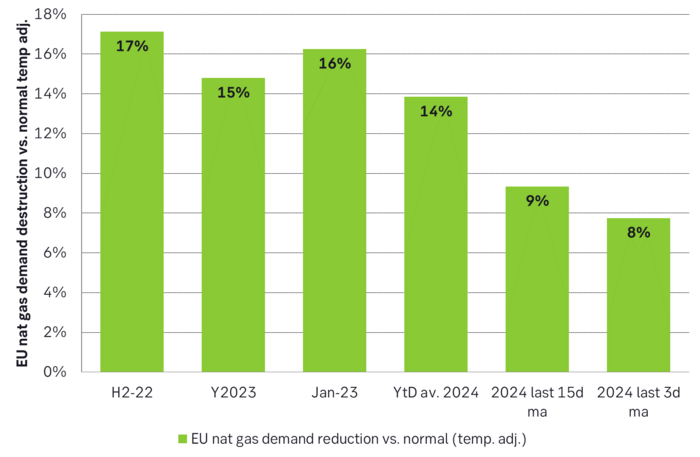
EU nat gas demand destruction has started to fade.
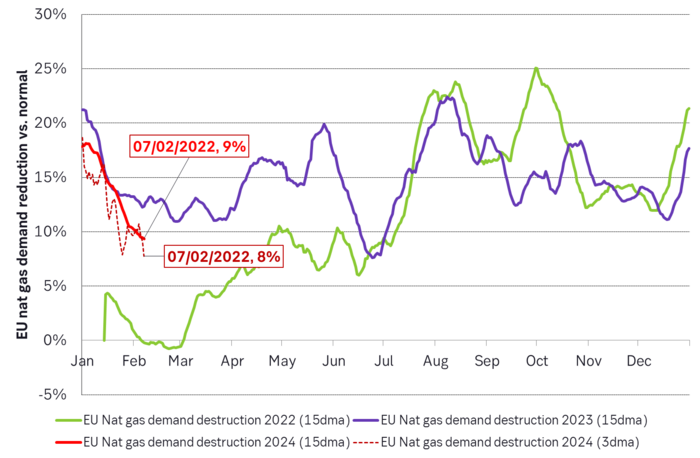
Forward Coal to Gas (C-t-G) differentials vs EUA market prices. The EUA price has balanced on the front-year differential. But that has now fallen like a rock along with the fall in front-year TTF nat gas price. Lead the EUA into a free-fall
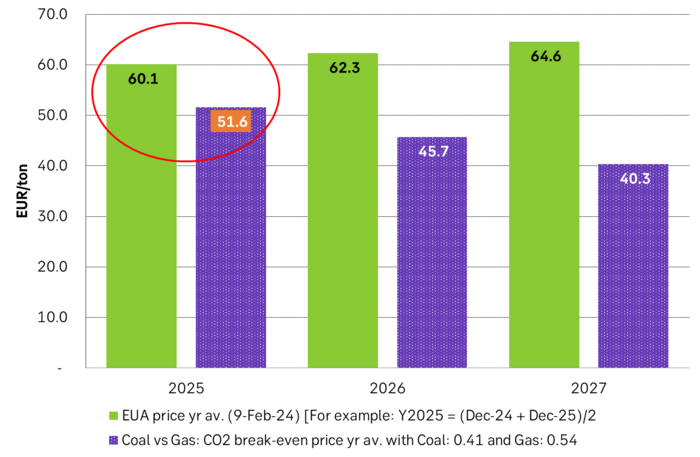
The front-year Coal-to-Gas differential is a distribution of crosses between many different levels of efficiencies for coal and nat gas power plants. Averages of these are EUR 52.4/ton with Coal at USD 94.3/ton and Nat gas at EUR 29.8/MWh (both front-year 2025 prices). So EUA price is still hanging high.
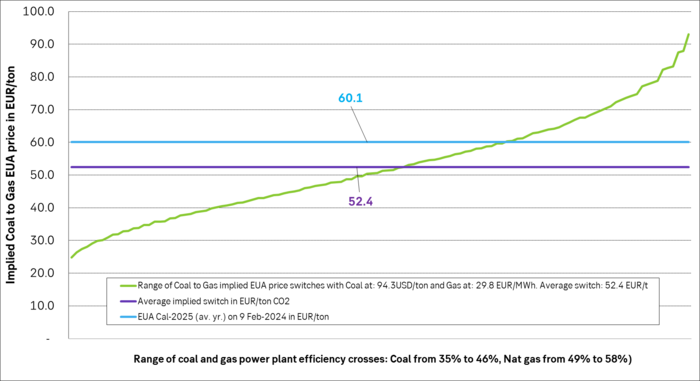
Analys
Tightening fundamentals – bullish inventories from DOE

The latest weekly report from the US DOE showed a substantial drawdown across key petroleum categories, adding more upside potential to the fundamental picture.

Commercial crude inventories (excl. SPR) fell by 5.8 million barrels, bringing total inventories down to 415.1 million barrels. Now sitting 11% below the five-year seasonal norm and placed in the lowest 2015-2022 range (see picture below).
Product inventories also tightened further last week. Gasoline inventories declined by 2.1 million barrels, with reductions seen in both finished gasoline and blending components. Current gasoline levels are about 3% below the five-year average for this time of year.
Among products, the most notable move came in diesel, where inventories dropped by almost 4.1 million barrels, deepening the deficit to around 20% below seasonal norms – continuing to underscore the persistent supply tightness in diesel markets.
The only area of inventory growth was in propane/propylene, which posted a significant 5.1-million-barrel build and now stands 9% above the five-year average.
Total commercial petroleum inventories (crude plus refined products) declined by 4.2 million barrels on the week, reinforcing the overall tightening of US crude and products.


Analys
Bombs to ”ceasefire” in hours – Brent below $70

A classic case of “buy the rumor, sell the news” played out in oil markets, as Brent crude has dropped sharply – down nearly USD 10 per barrel since yesterday evening – following Iran’s retaliatory strike on a U.S. air base in Qatar. The immediate reaction was: “That was it?” The strike followed a carefully calibrated, non-escalatory playbook, avoiding direct threats to energy infrastructure or disruption of shipping through the Strait of Hormuz – thus calming worst-case fears.

After Monday morning’s sharp spike to USD 81.4 per barrel, triggered by the U.S. bombing of Iranian nuclear facilities, oil prices drifted sideways in anticipation of a potential Iranian response. That response came with advance warning and caused limited physical damage. Early this morning, both the U.S. President and Iranian state media announced a ceasefire, effectively placing a lid on the immediate conflict risk – at least for now.
As a result, Brent crude has now fallen by a total of USD 12 from Monday’s peak, currently trading around USD 69 per barrel.
Looking beyond geopolitics, the market will now shift its focus to the upcoming OPEC+ meeting in early July. Saudi Arabia’s decision to increase output earlier this year – despite falling prices – has drawn renewed attention considering recent developments. Some suggest this was a response to U.S. pressure to offset potential Iranian supply losses.
However, consensus is that the move was driven more by internal OPEC+ dynamics. After years of curbing production to support prices, Riyadh had grown frustrated with quota-busting by several members (notably Kazakhstan). With Saudi Arabia cutting up to 2 million barrels per day – roughly 2% of global supply – returns were diminishing, and the risk of losing market share was rising. The production increase is widely seen as an effort to reassert leadership and restore discipline within the group.
That said, the FT recently stated that, the Saudis remain wary of past missteps. In 2018, Riyadh ramped up output at Trump’s request ahead of Iran sanctions, only to see prices collapse when the U.S. granted broad waivers – triggering oversupply. Officials have reportedly made it clear they don’t intend to repeat that mistake.
The recent visit by President Trump to Saudi Arabia, which included agreements on AI, defense, and nuclear cooperation, suggests a broader strategic alignment. This has fueled speculation about a quiet “pump-for-politics” deal behind recent production moves.
Looking ahead, oil prices have now retraced the entire rally sparked by the June 13 Israel–Iran escalation. This retreat provides more political and policy space for both the U.S. and Saudi Arabia. Specifically, it makes it easier for Riyadh to scale back its three recent production hikes of 411,000 barrels each, potentially returning to more moderate increases of 137,000 barrels for August and September.
In short: with no major loss of Iranian supply to the market, OPEC+ – led by Saudi Arabia – no longer needs to compensate for a disruption that hasn’t materialized, especially not to please the U.S. at the cost of its own market strategy. As the Saudis themselves have signaled, they are unlikely to repeat previous mistakes.
Conclusion: With Brent now in the high USD 60s, buying oil looks fundamentally justified. The geopolitical premium has deflated, but tensions between Israel and Iran remain unresolved – and the risk of missteps and renewed escalation still lingers. In fact, even this morning, reports have emerged of renewed missile fire despite the declared “truce.” The path forward may be calmer – but it is far from stable.
Analys
A muted price reaction. Market looks relaxed, but it is still on edge waiting for what Iran will do

Brent crossed the 80-line this morning but quickly fell back assigning limited probability for Iran choosing to close the Strait of Hormuz. Brent traded in a range of USD 70.56 – 79.04/b last week as the market fluctuated between ”Iran wants a deal” and ”US is about to attack Iran”. At the end of the week though, Donald Trump managed to convince markets (and probably also Iran) that he would make a decision within two weeks. I.e. no imminent attack. Previously when when he has talked about ”making a decision within two weeks” he has often ended up doing nothing in the end. The oil market relaxed as a result and the week ended at USD 77.01/b which is just USD 6/b above the year to date average of USD 71/b.

Brent jumped to USD 81.4/b this morning, the highest since mid-January, but then quickly fell back to a current price of USD 78.2/b which is only up 1.5% versus the close on Friday. As such the market is pricing a fairly low probability that Iran will actually close the Strait of Hormuz. Probably because it will hurt Iranian oil exports as well as the global oil market.
It was however all smoke and mirrors. Deception. The US attacked Iran on Saturday. The attack involved 125 warplanes, submarines and surface warships and 14 bunker buster bombs were dropped on Iranian nuclear sites including Fordow, Natanz and Isfahan. In response the Iranian Parliament voted in support of closing the Strait of Hormuz where some 17 mb of crude and products is transported to the global market every day plus significant volumes of LNG. This is however merely an advise to the Supreme leader Ayatollah Ali Khamenei and the Supreme National Security Council which sits with the final and actual decision.
No supply of oil is lost yet. It is about the risk of Iran closing the Strait of Hormuz or not. So far not a single drop of oil supply has been lost to the global market. The price at the moment is all about the assessed risk of loss of supply. Will Iran choose to choke of the Strait of Hormuz or not? That is the big question. It would be painful for US consumers, for Donald Trump’s voter base, for the global economy but also for Iran and its population which relies on oil exports and income from selling oil out of that Strait as well. As such it is not a no-brainer choice for Iran to close the Strait for oil exports. And looking at the il price this morning it is clear that the oil market doesn’t assign a very high probability of it happening. It is however probably well within the capability of Iran to close the Strait off with rockets, mines, air-drones and possibly sea-drones. Just look at how Ukraine has been able to control and damage the Russian Black Sea fleet.
What to do about the highly enriched uranium which has gone missing? While the US and Israel can celebrate their destruction of Iranian nuclear facilities they are also scratching their heads over what to do with the lost Iranian nuclear material. Iran had 408 kg of highly enriched uranium (IAEA). Almost weapons grade. Enough for some 10 nuclear warheads. It seems to have been transported out of Fordow before the attack this weekend.
The market is still on edge. USD 80-something/b seems sensible while we wait. The oil market reaction to this weekend’s events is very muted so far. The market is still on edge awaiting what Iran will do. Because Iran will do something. But what and when? An oil price of 80-something seems like a sensible level until something do happen.
-

 Nyheter4 veckor sedan
Nyheter4 veckor sedanMahvie Minerals växlar spår – satsar fullt ut på guld
-

 Analys4 veckor sedan
Analys4 veckor sedanA muted price reaction. Market looks relaxed, but it is still on edge waiting for what Iran will do
-

 Nyheter3 veckor sedan
Nyheter3 veckor sedanJonas Lindvall är tillbaka med ett nytt oljebolag, Perthro, som ska börsnoteras
-

 Nyheter3 veckor sedan
Nyheter3 veckor sedanOljan, guldet och marknadens oroande tystnad
-

 Nyheter3 veckor sedan
Nyheter3 veckor sedanDomstolen ger klartecken till Lappland Guldprospektering
-

 Analys3 veckor sedan
Analys3 veckor sedanTightening fundamentals – bullish inventories from DOE
-

 Nyheter2 veckor sedan
Nyheter2 veckor sedanRyska staten siktar på att konfiskera en av landets största guldproducenter
-

 Nyheter2 veckor sedan
Nyheter2 veckor sedanLundin Mining ska bli en av de tio största kopparproducenterna i världen







